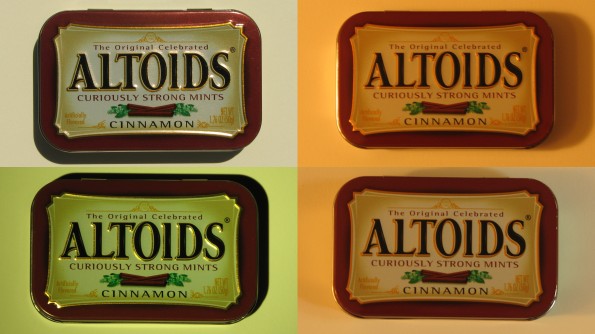Archive
White Balance and Time Lapse

A white balance set to "daylight" will distort color under different lighting conditions. (Daylight, tungsten (incandescent), halogen, and daylight/tungsten combination)
Today’s post is about white balance (WB). There are plenty of good explanations of WB on the internet, so I won’t go into too much detail, but I’ll focus on its importance in time lapse video. If you’re new to WB and want a detailed explanation, I’d suggest visiting Cambridge in Colour’s website.
A Quick Explanation of White Balance
White balance is how a camera determines the color range for a photograph. The human eye can see white under different lighting conditions and compensate, but a camera often has difficulty distinguishing appropriate colors under different light. For example, fluorescent light, incandescent light, and sunlight will create strange hues without proper compensation.
In the old days, film was marked “indoor” or “outdoor” and treated to provide appropriate colors under those two conditions. Most of us have seen old snapshots that were taken under inappropriate lighting conditions. The one that stands out in my mind is a picture of my uncle taken inside his store with what I assume was outside film. The picture, which isn’t very old, has a heavy yellow hue. As a snapshot, the hue doesn’t matter too much, but it would ruin an artistic print.
Modern cameras often come with automatic white balance (AWB), which works under most conditions. It’s far from perfect, but the amateur photographer won’t notice much distortion. The trouble with using AWB in time lapse video is that the camera continuously adjusts to changing light conditions and the hue will be inconsistent throughout the video. Here’s an example of a good time lapse unfortunately set to AWB (note the color of the clouds): Nov. 20
How to Properly Adjust White Balance
The good news is that the solution is fairly simple. Most cameras will allow you to pick from a few preset WB modes. Of these, “sunny” and “cloudy” work well for most naturally lit environments, and thus for most time lapse videos. Other settings include tungsten (for incandescent bulbs), fluorescent, flourescent H (for newer fluorescents), and flash. If you’re not sure whether your camera allows you to adjust WB, check your user’s manual. And remember to change your settings back when you’re done if you want to take snapshots.
Professional photographers often use a set of white or gray cards which they can use to manually adjust the camera’s WB. I don’t use these often, but they’re simple to make, and you can even calibrate WB with an index card for a ten cent solution.
Auto WB vs. Manual WB
There are arguments to be made whether you should shoot time lapse videos in full manual or automatic modes for things such as aperature, focal length, and shutter speed, but I’ve found that a static white balance is always preferable to AWB. The reason for this is that AWB will almost always be noticable in the final video. Manual WB might change hues during different lighting conditions, but the shift from sunny to cloudy is too subtle for most people to notice. If your subject is going to go from daylight to artificial lighting, it might be worth experimenting with AWB, overwise, stick to manual.
